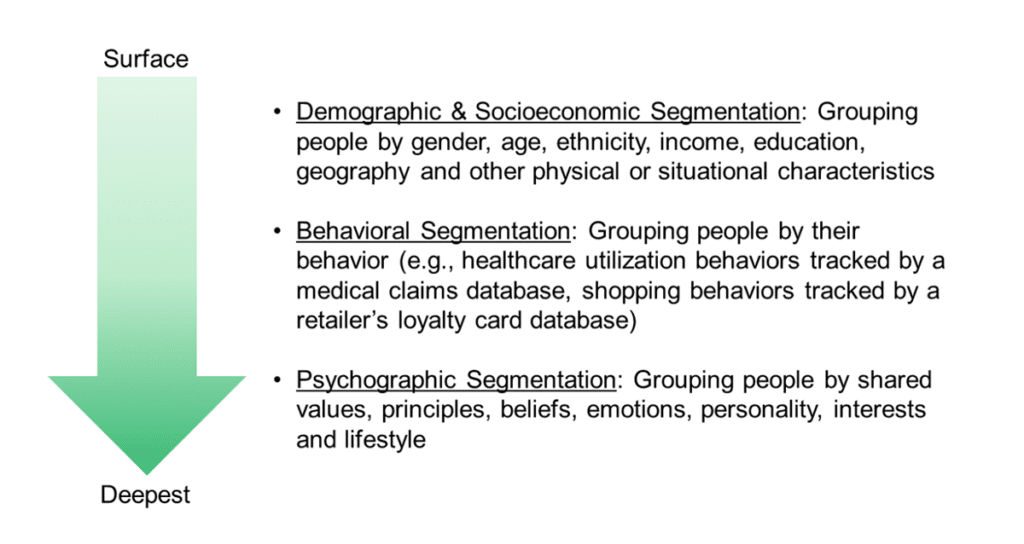Psychographics pertain to people’s values, attitudes, lifestyles and personalities. These are key to understanding motivations and why people do what they do. Consumer segmentation involves grouping people according to shared traits; thus, psychographic segmentation groups people according to shared motivations.
Harvard Business Review published an article titled, “Psychographics Are Just as Important for Marketers as Demographics,” by Alexandra Samuel. Ms. Samuel states that “Marketers are used to thinking and speaking in demographics, since slicing a market up by age, gender, ethnicity and other broad variables can help to understand the differences and commonalities among customers… but psychographics, which measure customers’ attitudes and interests rather than ‘objective’ demographic criteria, can provide deep insight that complements what we learn from demographics.”
Any segmentation is arguably better than no segmentation, but demographic segmentation assumes that everyone in a group defined by physical traits thinks and acts alike, which we know is not the case. Ms. Samuel uses examples that may be familiar to many marketing teams: “Our target audience is 14-34 years olds” or “We are launching a campaign aimed at urban Latinos.” While the groups may share common cultural and situational context, it is safe to assume these two groups are not made up of people who all have the same personality, priorities or motivations. Diversity of thought is an important consideration when appealing to a target audience.
Different Types of Consumer Segmentation
In addition to demographics are socioeconomics, where segmentation groups consumers according to income, household assets, education, political affiliation and other variables.
As its name suggests, behavioral segmentation groups consumers according to similar behaviors. A highly visible application of behavioral segmentation is with consumer goods retailers, like a grocery chain. Loyalty programs allow retailers to track the purchase behaviors of their shoppers to predict future purchase behavior and even incentivize it with coupons and discounts. This is a powerful and lucrative tool for retailers, but it only uncovers what consumers are doing, not why they are doing it.
Psychographic segmentation variables go deeper to uncover the why, and if one knows the why, one can customize messaging and media according to consumers’ communication preferences and appeal to their motivations.

All that said, psychographic segmentation should not necessarily replace good demographic or behavioral segmentation work. Psychographic segmentation can augment this work, informing and strengthening a marketing team’s consumer understanding efforts. Moreover, until recently, demographic and behavioral data were easier to identify in a population. Many vendors supply contact lists of consumers based on demographic data and retailers, consumer goods companies and healthcare organizations have rich databases of consumer behavior data. Psychographic data are now being operationalized, but we will cover this more under the subheading, “Making Psychographic Segmentation Actionable” below.
Psychographic Segmentation in Health Care
Healthcare organizations, such as hospitals, health systems and insurance companies, have long segmented patients/members according to health conditions and utilization patterns, in addition to demographics. Targeting a population with, or at risk for, a disease makes sense, especially when that disease affects so many patients and costs the system significantly. However, every patient with a certain health condition does not think and act alike, either.
Take diabetes, for example. I have known some healthcare companies (especially in the pharmaceuticals space) that segment patients with diabetes according to stage or treatment: pre-diabetes; newly diagnosed Type 2 diabetes; ongoing management of diabetes; advanced diabetes, etc. Granted, patients may share certain externally defined priorities (e.g., what experts say the patient should be doing) within each stage and behaviors may be similar. However, not everyone who is newly diagnosed reacts the same way to the news or walks lock-step according to the physician’s direction.
Moreover, this is a disease-centered approach, treating the patient like a “walking health condition.” Patients are obviously more complex than this, with many responsibilities, interests and priorities beyond their health condition in their everyday lives. Most people do not define themselves by their health condition, so a healthcare provider focusing only on the disease misses the majority of what drives a patient’s actions.
Psychographic segmentation can help healthcare providers gain a deeper understanding of their patients/members by uncovering personality- and attitudinally-driven motivations. These insights factor into patient engagement through both marketing and medical care.
Upfront has developed a psychographic segmentation model focused on health and wellness. By answering 12 simple questions, a healthcare consumer can be classified as one of five distinct psychographic segments with 91.1% predictability. Each segment has unique motivations and communication preferences; the percentage following the psychographic segment name below represents the percentage of the general population represented by that segment:
- Self Achievers (21%) –The most proactive and wellness-oriented group, Self Achievers are ready to be in the driver’s seat but appreciate directive guidance. Goal and task-oriented, they appreciate measures to gauge progress in their efforts. They are the most willing to spend whatever it takes to be healthy.
- Balance Seekers (15%) – Balance Seekers are also proactive and wellness-oriented, but they downplay the role of healthcare professionals. They prefer options and suggestive approaches and are open to alternative medicine rather than being given an already mapped-out route to wellness and directive healthcare.
- Priority Jugglers (12%) – Priority Jugglers tend to be less proactive and engaged with their own healthcare because they put other responsibilities ahead of personal health; however, they are proactive in managing their family’s health. They may require a higher level of interaction to keep them focused on their own health behaviors.
- Trustful Responders (15%) – Trustful Responders prefer to be told by healthcare professionals what they need to do; after all, clinicians are the experts in their eyes. They like to cut to the chase and do not like to be asked a lot of questions. This segment reflects the way healthcare has been delivered traditionally; unfortunately, this resonates with only 15% of the population.
- Willful Endurers (37%) – Willful Endurers are independent and the least proactive about their health. They live in the moment and do not focus on long-term benefits or consequences. The challenge is to find ways to motivate them toward adopting healthy behaviors through immediate gratification.
This is a “4th generation” health and wellness model stemming from work led by healthcare consumer experts from Upfront during their careers at P&G, where they evolved three previous psychographic segmentation models on behalf of P&G’s healthcare brands and customers. Upfront’s current psychographic segmentation model was developed in early 2013 and validated in early 2015 with little to no differences in segment attitudes and behaviors, indicating a stable model. The model has held stable and consistent through annual national market research studies through 2022.
Making Psychographic Segmentation Actionable
In the past, psychographic segmentation has been difficult to operationalize for patient engagement over a large population, because there were few databases of people, with contact information, focused on attitudes and values. Consumer products companies and retailers would develop personae of psychographic segments and choose a “Prime Prospect” consumer type (typically the most profitable, or high growth potential consumer segment) against which it would focus its mass marketing campaigns. The technology did not exist for efficient one-to-one marketing based on an individual consumer’s psychographic profile.
In her HBR article, Ms. Samuel points out, “The internet has changed the relative importance of demographics and psychographics to marketers in three key ways: by making psychographics more actionable, by making psychographic differences more important, and by making psychographic insight easier to access.”
The advent of social media and data-driven companies like Facebook has made psychographic analysis and segmentation practical for companies seeking to execute against these insights. Placing marketing messages in front of consumers based on their interests is now commonplace.
The healthcare industry may have been generally slow in adopting psychographic segmentation, but now is the right time to capitalize on it, especially in an environment that is increasingly moving toward consumerism. Innovative companies are empowering healthcare organizations to leverage psychographic segmentation in patient engagement.
Upfront’s platform for automating patient engagement (email, text/SMS, Interactive Voice Response, Microsites), personalizes its messaging according to patients’ psychographic profile and other aspects of behavioral science. Upfront addresses important things like missed appointments, health education, patient reactivation and recall, ER visit reduction and hospital readmissions. In one case involving a rural health system providing care to Medicaid, Hispanic and underserved populations, Upfront reduced missed appointments by 22%, helping patients get needed care.
Ms. Samuel closes off her HBR article with the following statements, with which I couldn’t agree more:
“While the internet has made psychographics more important than ever, today’s research, analytics, and ad targeting make it newly possible to turn those psychographics into the foundation of a robust market research and marketing strategy. Indeed, in the best-case scenario, thoughtful use of psychographics will help you develop not only the messages and campaigns but also the products and services that specific customers want and need.”
Contact us today to learn more by downloading our whitepaper on Psychographic Segmentation.







